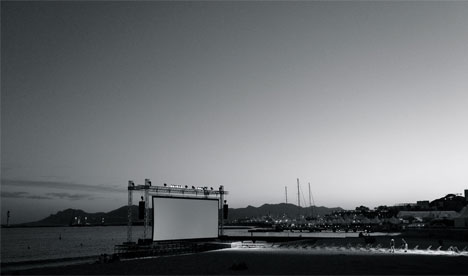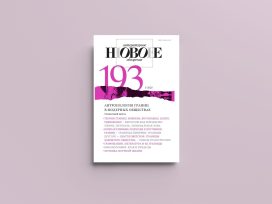Three years ago, in the spring of 2011, I read at home the reports my colleagues in journalism and criticism filed from the biggest European film festivals, and I felt it was entirely unnecessary for me to attend these hugely important film events on the old continent in order to gain first-hand experience myself. Why should I? All the films that are significant in any way whatsoever sooner or later find their way to our cinemas, and any that elude Slovenian distributers I can in any case learn about online if they are really that good. Ultimately everything will be available within a few weeks of the premiere. And frankly speaking the majority of critics do not attend festivals, because it costs too much. So I also didn’t feel the need to go, and there was nothing at all that would have shaken this firm conviction of mine.

Screen on the beech, Cannes Film Festival, 2012. Photo: yaprak kyd. Source:Flickr
Today, only three years later, after having attended three Venice Film Festivals, two in Cannes and one Berlinale, I can hardly believe I once thought in such a cloistered way.
What exactly is so invaluable about this experience for critics and journalists? If I were to say that it completely changed my way of looking at the world of film, that would be just one side of the story. My critical and theoretical apparatus, which was developed alongside structuralist literature, has of course remained more or less the same and it would be difficult to replace it quickly even if I wanted to. There is a perk of a different order here: as a critic at a festival you are placed in a situation in which you must write a review just a few minutes after leaving the theatre where you watched the world premiere of a film, of which you knew nothing beforehand. No advertising and promotional messages that – and from today’s perspective I see this even more clearly – constantly bombard us from all sides and influence in so many ways the formation of opinions about films. To be completely alone with the film and one’s opinion of it is something radically different, and a film critic who lacks that experience is, to put it plainly, not a film critic.
But no – I also have in mind some completely different things, which cannot be seen from a domestic perspective. In Slovenia, a person does not have a sense of the size and importance of these two-week events, in which the whole of the global film industry is involved. These are events at which more films are screened in two weeks than in Slovenian cinemas in a whole year. The variety of film in all sections at festivals is astounding. Such a festival puts you in a completely different frame of mind to events in the home environment. Quite simply, there is no greater event elsewhere, it is this place that is the very centre of the film world. If today I were to say that I can follow such an event via Internet news and that I’ll be kept informed of everything that happens there, this is purely a media illusion, and one that is damaging – but at the same time clearly in the interest of some.
Both the art of film and the film industry, despite their youth, are well beyond the phase of being the purview of individual enthusiasts; rather, they are embedded in institutional frameworks at all levels and involve significant amounts of private and public capital, such that they constitute an important part of the social system. What I began to see from the perspective of this kind of festival event is that a nationally insulated media space such as Slovenia’s has its own strategy of building interpretations, which occurs independent of the global space. Not just the Slovenian but every national public discourse is a sort of parallel world that develops independently of the global. The more distant it is from the centre – geographically, culturally, ideologically – the more different it is. But what concerns me here is that writing about film in Slovenia is in large degree subjected to advertising and that this fact is in large degree undisclosed. Due to the weak financial and consequently also ethical position of the media, many journalists who write about film are embedded in advertising, while also increasingly absent from these festivals. Instead, financiers, producers, distributers and cinemas build a powerful advertising apparatus that is exclusively affirmative and favourably disposed only towards those films that these institutions launch to the public.
In practice it looks like this: in the nationwide daily newspaper Delo in mid-March, Irena Staudohar’s article entitled “Home alone and alone in the cinema” explains what an exciting time we live in since there are good quality films all around us. In the author’s view, the number of older filmgoers has greatly increased, which has contributed to the production of good quality films. And this year’s Oscars are in her opinion evidence of this. Even more, in Slovenia, too, everything is blooming. Cinema in her view is moving from the suburbs back into the cities. She says that this is shown by Kinodvor, the biggest art cinema in the country, with its “excellent program”, and full praise also goes to the multiplex company Kolosej, which has again opened up a theatre in the centre of the city. “Multiplexes are gradually waning, and once again ideas are what count”, she writes in conclusion.
That today this sort of writing, which sounds like an institutional advertisement, is accepted in Slovenia’s largest print media by editors as well as readers as an example of journalism at the national level, is very sad. Intuitively this writing appears truthful but in truth it has no contact with reality and indicates the total lack of knowledge of the author, who yields to conceptions of film art as some sort of romantic art. Every word conceals the actual state of affairs, every claim ends affirmatively, in praise of the filmmakers as well as the cinemas.
In the real world trends are occurring which are strongly negative, but these are barely cited, let alone examined in the media – that would not be in the interests of the institutions praised by this Delo journalist. That we do not by a long shot live in an exciting time for the art of film but rather are experiencing just a repetition of things already seen, I merely mention by the way. More important in the context of the author’s words is that at this moment in Slovenia city cinemas are being strongly commercialized. Digitalization, which in recent years has also reached cinema in Slovenia, instead of providing cultural, aesthetic and historical diversity, has given way to the unexpected trend of the commercialization of films on offer, governed by a strategy of seeking out a target audience which now also includes older viewers.
There is no longer space for masterpieces such as Wiseman’s Berkeley or Lanzmann’s The Last of the Unjust. Previously, in addition to a range of thoroughly mediocre quasi-intellectual European films, we could also see a cycle of Oscar winners in city cinemas. These at least bring a profit but, of course, all of this uses public money in one way or another. And the criteria that was once implied by labelling a cinema an art cinema today no longer applies: city cinemas have become twinned with the multiplex commercial discourse and are no longer its opposite, providing an alternative film experience. Of course the author completely overlooks the fact – in the characteristic centralist light that is typical for the Ljubljana “national” media – that city cinemas outside Ljubljana are facing entirely different problems and that the wave of commercialization has come in extremely useful for them, instead of providing for the expansion of film culture in the full sense of the word.
From my own experience, I can assert that film criticism writing frequently discredits the representatives of institutions when they try to show that you are an ill-informed quasi-expert spouting nonsense and criticizing things that everybody else in fact praises. It seems that this state of unwillingness to leap outside established frameworks merely reflects the current social mentality in Slovenia. This state of being trapped between the routine of established meaning and the search for short-lived happiness raises a topic that is distinctly filmic. We are missing reality, we have many illusions, and the best way of breaking them down is the relativization of majority values through greater inclusion in the international space. But as long as what capitalist jargon, which extends to the field of culture as well, calls competitiveness – and this competitiveness is not only material but also intellectual – represents a threat to the majority conception of things, then things will not change. So long as journalists even in a marginal area such as film fail to see their task as describing the actual state of affairs and critiquing the dominant institutional discourse, then the broader lay public will continue to be satisfied with what it has grown accustomed to.







